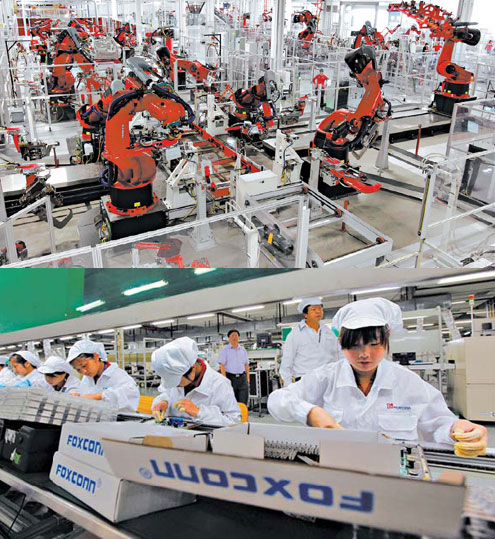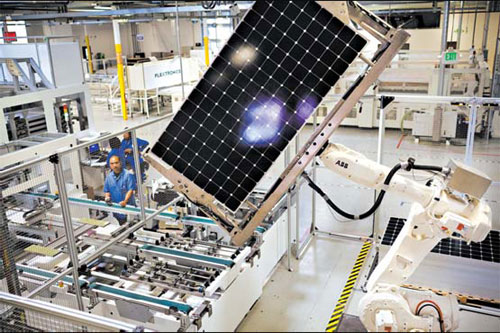Skilled work, without the worker
Updated: 2012-08-26 07:59
By John Markoff (
The New York Times
)
|
||||||||
|
|
Drachten, the Netherlands - At the Philips Electronics factory on the coast of China, hundreds of workers use their hands and specialized tools to assemble electric shavers. That is the old way.
At a sister factory here in the Dutch countryside, 128 robot arms do the same work with yoga-like flexibility. Video cameras guide them through feats well beyond the capability of the most dexterous human.
One robot arm endlessly forms three perfect bends in two connector wires and slips them into holes almost too small for the eye to see. The arms work so fast that they must be enclosed in glass cages to prevent the people supervising them from being injured. And they do it all without a coffee break - three shifts a day, 365 days a year.
All told, the factory here has several dozen workers per shift, about a tenth as many as the plant in the Chinese city of Zhuhai.
This is the future. A new wave of robots, far more adept than those now commonly used by automakers and other heavy manufacturers, are replacing workers around the world in both manufacturing and distribution. Factories like the one here in the Netherlands are a striking counterpoint to those used by Apple and other consumer electronics giants, which employ hundreds of thousands of low-skilled workers.
"With these machines, we can make any consumer device in the world," said Binne Visser, who manages the Philips assembly line in Drachten.
Many industry executives and technology experts say Philips's approach is gaining ground on Apple's. Even as Foxconn, Apple's iPhone manufacturer, continues to build new plants and hire thousands of additional workers to make smartphones, it plans to install more than a million robots within a few years to supplement its work force in China.
Foxconn has not said how many workers will be displaced. But its chairman, Terry Gou, has endorsed a growing use of robots. Speaking of his more than one million employees, he said in January, according to the official Xinhua news agency: "As human beings are also animals, to manage one million animals gives me a headache."
The falling costs and growing sophistication of robots have renewed a debate over how quickly jobs will be lost. This year, Erik Brynjolfsson and Andrew McAfee, economists at the Massachusetts Institute of Technology, made the case for a rapid transformation. "The pace and scale of this encroachment into human skills is relatively recent and has profound economic implications," they wrote in their book, "Race Against the Machine."
In their minds, the advent of low-cost automation foretells changes on the scale of the revolution in agricultural technology over the last century, when farming employment in the United States fell from 40 percent of the work force to about 2 percent.
But Bran Ferren, a veteran roboticist and industrial product designer at Applied Minds in Glendale, California, argues that there are still steep obstacles. "I had an early naivete about universal robots that could just do anything," he said. "You have to have people around anyway. And people are pretty good at figuring out, how do I wiggle the radiator in or slip the hose on? And these things are still hard for robots to do."
Beyond the technical challenges lies resistance from unionized workers and communities worried about jobs. Even though rising labor and transportation costs in Asia and fears of intellectual property theft are now bringing some work back to the West, the ascension of robots may mean fewer jobs will be created.
At the Flextronics solar panel factory in Milpitas, south of San Francisco, a banner proclaims, "Bringing Jobs & Manufacturing Back to California!" Yet in the plant, there are robots everywhere and few human workers. All of the heavy lifting and almost all of the precise work is done by robots. The human workers trim excess material, thread wires and screw in a handful of fasteners.
Such advances in manufacturing are also transforming other sectors that employ millions of workers. One is distribution, where robots that zoom at the speed of the world's fastest sprinters can store, retrieve and pack goods for shipment far more efficiently than people.
Rapid improvement in vision and touch technologies is putting a wide array of manual jobs within the abilities of robots. For example, Boeing's wide-body commercial jets are now riveted automatically by giant machines that move rapidly and precisely over the skin of the planes.
And at Earthbound Farms in California, four newly installed robot arms with customized suction cups swiftly place clamshell containers of organic lettuce into shipping boxes. Each robot replaces two to five workers at Earthbound.
A Robot Race Takes Shape
|
Robots at the Flextronics solar panel factory in Milpitas, California, do all the heavy lifting and almost all of the precise work, requiring little human help. Lianne Milton for The New York Times |
At an automation trade show last year in Chicago, Ron Potter, the director of robotics technology at an Atlanta consulting firm called Factory Automation Systems, offered an example of a robotic manufacturing system that initially cost $250,000 and replaced two machine operators, each earning $50,000 a year. Over the 15-year life of the system, the machines yielded $3.5 million in labor and productivity savings.

 Relief reaches isolated village
Relief reaches isolated village
 Rainfall poses new threats to quake-hit region
Rainfall poses new threats to quake-hit region
 Funerals begin for Boston bombing victims
Funerals begin for Boston bombing victims
 Quake takeaway from China's Air Force
Quake takeaway from China's Air Force
 Obama celebrates young inventors at science fair
Obama celebrates young inventors at science fair
 Earth Day marked around the world
Earth Day marked around the world
 Volunteer team helping students find sense of normalcy
Volunteer team helping students find sense of normalcy
 Ethnic groups quick to join rescue efforts
Ethnic groups quick to join rescue efforts
Most Viewed
Editor's Picks

|

|

|

|

|

|
Today's Top News
Health new priority for quake zone
Xi meets US top military officer
Japan's boats driven out of Diaoyu
China mulls online shopping legislation
Bird flu death toll rises to 22
Putin appoints new ambassador to China
Japanese ships blocked from Diaoyu Islands
Inspired by Guan, more Chinese pick up golf
US Weekly

|

|








